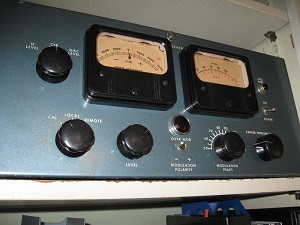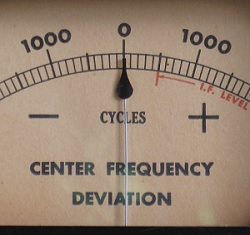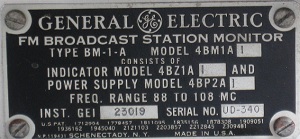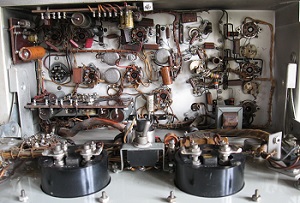Vintage Audio: GE BM-1-A FM Monitor | Telos Alliance
By The Telos Alliance Team on Jul 16, 2014 12:00:00 PM
 Vintage Tech: GE BM-1-A FM Monitor
Vintage Tech: GE BM-1-A FM Monitor
During the golden age of radio, all of America's largest electronics manufacturers were engaged, as there was lots of money and prestige to be had building broadcast equipment. RCA, Raytheon, Westinghouse and General Electric were all big players. By the 1960s, the AM and FM expansions were pretty much over. One by one, these big firms got out of broadcasting, often to pursue more lucrative government contracts as the war in Vietnam escalated.
Our attic discovery this month is a survivor from those early days of FM broadcasting, a 1948 General Electric BM-1-A FM monitor. Designed to measure both percentage modulation and center frequency, this monitor has 14 tubes and requires an external power supply.
Frequency deviation is indicated by an illuminated meter which can be switch-selected to indicate IF level, discriminator output and RF input level. Into the mid-1970s, the FCC required radio stations to have type-approved frequency monitors, and readings had to be logged every 30 minutes. For FM transmitters, the carrier frequency had to be maintained within +/- 2000 cycles.
To measure frequency, the monitor had a 'run' crystal in a constant-temperature oven. The frequency of this crystal was multiplied either 24 or 27 times, depending on the station's operating frequency. The final harmonic frequency was heterodyned with the station frequency to produce a 5.4 Mc IF.
In order to check the calibration of the FM monitor, a second 'calibrate' crystal operating at 5.4 Mc was installed. A front-panel switch would turn the cal oscillator on and switch the second heterodyne multiplier stage was turned off. The front-panel 'center frequency' control was then used to zero the frequency meter.
Audio output was provided by a two-stage amplifier (both halves of a 6SN7) driven through the de-emphasis circuit by the output of the discriminator. Two audio outputs were provided. A 600-ohm line level out was available for monitoring, and a high-level unbalanced output was provided for making noise and distortion measurements. A flasher circuit was made up of a GL-502-A gas triode tube, a flasher lamp and an alarm relay. The flasher tube is driven by a cathode follower, and its bias may be set by the front-panel 'modulation peaks' control to cause it to fire at any predetermined modulation level.
This unit was in service when transmitter sites were required to be manned. There were no outside antennas or RF amplifiers. The monitor was connected directly to an RF sample from the transmitter. About 1 watt of RF was required. Typically this came from a short loop of wire in the PA cabinet. Bending the loop could control the output level to some degree. That, and 50-ohm RF attenuators were sufficient to knock the sample signal down to around 1 watt.
Provisions were also provided for extension meters and a remote peak flasher. These were often used in conjunction with a transmitter control console, in this case, the GE BC-3-A.
General Electric was a big player in broadcasting during the golden age of radio, both as an equipment manufacturer and owner of radio stations. With manufacturing facilities in Schenectady, NY, GE had a full product line of AM-FM-TV equipment. They also did large custom projects, including several 100 Kw HF transmitters for the Voice of America's Greenville, NC site. During the 1960s, sales began to fall off. In the late ‘60s, GE sold its broadcast division to Gates (now GatesAir ), who was primarily interested in expanding from radio into television. For many years, GE manuals were available from Harris, if you knew who to ask. Replacement parts were not as easy to come by.
), who was primarily interested in expanding from radio into television. For many years, GE manuals were available from Harris, if you knew who to ask. Replacement parts were not as easy to come by.
This particular GE monitor surfaced while cleaning out the workshop of a Boston FM station. It was in service for a number of years, and the inside has evidence of numerous repairs, some neatly done, others not so much. Sadly, the companion BP-2-A power supply was nowhere to be found. The BM-1 has long been on display, occasionally with the front panel meters illuminated. It makes a nice conversation piece.
Telos Alliance has led the audio industry’s innovation in Broadcast Audio, Digital Mixing & Mastering, Audio Processors & Compression, Broadcast Mixing Consoles, Audio Interfaces, AoIP & VoIP for over three decades. The Telos Alliance family of products include Telos® Systems, Omnia® Audio, Axia® Audio, Linear Acoustic®, 25-Seven® Systems, Minnetonka™ Audio and Jünger Audio. Covering all ranges of Audio Applications for Radio & Television from Telos Infinity IP Intercom Systems, Jünger Audio AIXpressor Audio Processor, Omnia 11 Radio Processors, Axia Networked Quasar Broadcast Mixing Consoles and Linear Acoustic AMS Audio Quality Loudness Monitoring and 25-Seven TVC-15 Watermark Analyzer & Monitor. Telos Alliance offers audio solutions for any and every Radio, Television, Live Events, Podcast & Live Streaming Studio With Telos Alliance “Broadcast Without Limits.”
Recent Posts
Subscribe
If you love broadcast audio, you'll love Telos Alliance's newsletter. Get it delivered to your inbox by subscribing below!